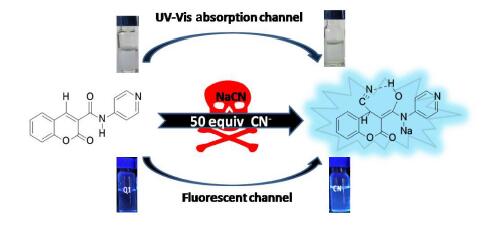| [1] Zamecnik, J.; Tam, J. J. Anal. Toxicol. 1987, 11, 47.
[2] Anderson, R. A.; Harland, W. A. Med. Sci. Law. 1982, 22, 35.
[3] Suzuki, T.; Hioki, A.; Kurahashi, M. Anal. Chim. Acta 2003, 476, 159.
[4] Christison, T. T.; Rohrer, J. S.; J. Chromatogr., A 2007, 1155, 31.
[5] Surleva, A. R.; Nikolova, V. D.; Neshkova, M. T. Anal. Chim. Acta 2007, 583, 174.
[6] Yen, S.; Wang, C.-T.; Wang, J.-S. Chem. Eng. Commun. 1991, 109, 167.
[7] Bhalla, V.; Singh, H.; Kumar, M. Dalton Trans. 2012, 41, 11413.
[8] Chattaraj, S.; Das, A. K. Analyst 1991, 116, 739.
[9] Zhang, Y.-M.; Shi, B.-B.; Zang, P.; Huo, J. Q.; Chen, P.; Lin, Q.; Liu, J.; Wei, T.-B. Sci. China, Chem. 2013, 56, 612.
[10] Lin, Q.; Liu, X.; Chen, P.; Wei, T.-B.; Zhang, Y.-M. Prog. Chem. 2013, 25, 2131(in Chinese). (林奇, 刘昕, 陈佩, 魏太保, 张有明, 化学进展, 2013, 25, 2131.)
[11] Li, W.-T.; Qu, W-J.; Zhang, H.-L.; Li, X.; Lin, Q.; Yao, H.; Zhang, Y.-M.; Wei, T.-B. Chin. J. Org. Chem. 2017, 37, 754(in Chinese). (李文婷, 曲文娟, 张海丽, 李翔, 林奇, 姚虹, 张有明, 魏太保, 有机化学, 2017, 37, 754.)
[12] Li, X.; Lin, Q.; Qu, W-J.; Li, Q.; Chen, X.-B.; Li, W.-T.; Zhang, Y.-M.; Yao, H.; Wei, T.-B. Chin. J. Org. Chem. 2017, 37, 889(in Chinese). (李翔, 林奇, 曲文娟, 李乔, 程晓斌, 李文婷, 张有明, 姚虹, 魏太保, 有机化学, 2017, 37, 889.)
[13] Lin, Q.; Fu, Y.-P.; Chen, P.; Wei, T.-B.; Zhang, Y.-M. Dyes Pigm. 2013, 96, 1.
[14] Zhang, Y.-M.; Lin, Q.; Wei, T.-B.; Li, Y.; Qin, X.-P. Chem. Commun. 2009, 40, 6074.
[15] Lin, Q.; Wei, T.-B.; Yao, H.; Zhang, Y.-M. Acta Chim. Sinica 2007, 65, 159(in Chinese). (林奇, 魏太保, 姚虹, 张有明, 化学学报, 2007, 65, 159.)
[16] Lee, K. H.; Chai, H. B.; Tamez, P. A. Phytochemistry 2003, 64, 535.
[17] Pai, N. R.; Vishwasrao, S.; Wankhede, K. J. Chem. Pharm. Res. 2012, 4, 4946.
[18] Kudo, E.; Taura, M.; Matsuda, K.; Shimamoto, M.; Kariya, R.; Goto, H.; Hattori, S.; Kimura, S.; Okada, S. Bioorg. Med. Chem. Lett. 2013, 23, 606.
[19] Jung, J. C.; Kin, J.; Park, O. S. Synth. Commun. 2001, 31, 1195.
[20] Anand, P.; Singh, B.; Singh, N. Bioorg. Med. Chem. 2012, 20, 1175.
[21] Kobayashi, H.; Ogawa, M.; Alford, R.; Choyke, P. L.; Urano, Y. Chem. Rev. 2010, 110, 2620.
[22] Huang, X.-H.; Zhang, G.-X.; Zhang, D.-Q. Acta Chim. Sinica 2012, 70, 2133(in Chinese). (黄显虹, 张关心, 张德清, 化学学报, 2012, 70, 2133.)
[23] Ma, W.-H.; Xia, W.; Xu, Q.; Han, H.-Y.; Song, B.; Sun, L.-W.; Liang, C.-H. Acta Chim. Sinica 2012, 70, 917(in Chinese). (马文辉, 夏威, 徐群, 韩宏彦, 宋波, 孙丽微, 梁春花, 化学学报, 2012, 70, 917.)
[24] Liu, G.; Cao, H.-Y.; Shao, J. Chin. J. Org. Chem. 2011, 31, 1678(in Chinese). (刘阁, 曹洪玉, 邵杰, 有机化学, 2011, 31, 1678.)
[25] Roy, N.; Dutta, A.; Mondal, P.; Paul, P. C.; Takhellambam, S. S. Sens. Actuators, B 2016, 236, 719.
[26] Hu, J.-H.; Sun, Y.; Qi, J.; Li, Q.; Wei, T.-B. Spectrochim. Acta, Part A 2017, 175, 125.
[27] Zhang, P.; Zhang, Y.-M.; Lin, Q.; Yao, H.; Wei, T.-B. Chin. J. Org. Chem. 2014, 34, 1300(in Chinese). (张鹏, 张有明, 林奇, 姚虹, 魏太保, 有机化学, 2014, 34, 1300.)
[28] Hossain, S. M.; Singh, K.; Lakma, A.; Pradhan, R. N.; Singh, A. K. Sens. Actuators, B 2017, 239, 1109..
[29] Gao, Y.; Liu, H.-M.; Li, P.; Liu, Q.-L.; Wang, W.; Zhao, B. Tetrahedron Lett. 2017, 58, 2193.
[30] Wang, S.-J.; Li, C.-W.; Li, J.; Chen, B.; Guo, Y. Acta Chim. Sinica 2017, 75, 383(in Chinese). (王少静, 李长伟, 李锦, 陈邦, 郭媛, 化学学报, 2017, 75, 383.)
[31] Ma, L.-L.; Leng, T.-H.; Wang, K.; Wang, C.-Y.; Shen, Y.-J.; Zhu, W.-H. Tetrahedron 2017, 73, 1306.
[32] Hu, J.-H.; Li, J.-B.; Qi, J.; Sun, Y. N. J. Chem. 2015, 39, 4041.
[33] Saha, S.; Ghosh, A.; Mahato, P.; Mishra, S.; Mishra, S. K.; Suresh, E.; Das, S.; Das, A. Org. Lett. 2010, 12, 3406.
[34] Kumari, N.; Jha, S.; Bhattacharya, S. J. Org. Chem. 2011, 76, 8215.
[35] Lin, Q.; Chen, P.; Fu, Y.-P.; Zhang, Y.-M.; Shi, B.-B.; Zhang, P.; Wei, T.-B. Chin. Chem. Lett. 2013, 24, 699.
[36] Li, W.-T.; Qu, W.-J.; Zhu, X.; Li, Q.; Zhang, H.-L.; Yao, H.; Lin, Q.; Zhang, Y.-M.; Wei, T.-B. Sci. China Chem. 2017, 60, 1.
[37] Lin, Q.; Chen, P.; Liu, J.; Fu, Y.-P.; Zhang, Y.-M.; Wei, T.-B. Dyes Pigm. 2013, 98, 100.
[38] Zhu, X.; Lin, Q.; Lou, J.-C.; Lu, T.-T.; Zhang, Y.-M.; Wei, T.-B. New J. Chem. 2015, 39, 7206.
[39] Leng, Y.-L.; Zhang, J.-H.; Li, Q.; Zhang, Y.-M.; Lin, Q.; Yao, H.; Wei, T.-B. New J. Chem. 2016, 40, 8607.
[40] Wang, L.-Y.; Ye, D.-C.; Cao, D.-R. J. South China Univ. Technol. 2012, 40, 46(in Chinese). (汪凌云, 叶德成, 曹德榕, 华南理工大学学报, 2012, 40, 46.)
[41] Li, Q.; Zhang, J. H.; Cai, Y., Qu.; W. J.; Gao, G. Y.; Lin, Q.; Yao, H.; Zhang, Y.-M.; Wei, T.-B. Tetrahedron 2015, 71, 857. |
